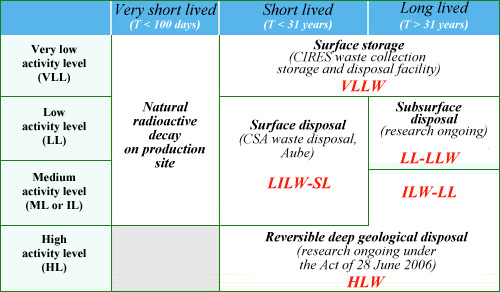Classification to ensure radioactive waste is managed appropriately
Classification is necessary to ensure the management of radioactive waste suits the type, volume and risks of the waste concerned. We sometimes forget that the waste from nuclear reactors is not the only type of waste that has to be managed. In France, five major waste categories have been defined.
These five categories are: very low-level waste (VLLW), low- and intermediate-level short-lived waste (LILW-SL), intermediate-level long-lived waste (ILW-LL), high-level waste (HLW) and finally low-level long-lived waste (LLW-LL). Under an old classification system, LILW-SL, ILW-LL and HLW were previously known as waste types A, B and C.

French radioactive waste classification system
The French system for classifying radioactive waste is based on the criteria of radioactivity level and life span determined by the half-life, T, of the main radioelements in the waste. On the basis of these two criteria, the French National Radioactive Waste Management Agency (ANDRA) has defined 5 classes of waste to be managed.
© ANDRA
Very low-level waste (VLLW) presents the least risk. The volume of this waste will increase when the nuclear power plants currently in operation are dismantled.
Low- and intermediate-level waste (LILW-SL) alone accounts for 63% of the total volume of waste but only 0.02% of the total activity. It contains radioactive products that do not come from irradiated fuel. They come from various sources: contaminated objects (gloves, resins, filters) from nuclear plants, but also from laboratories, hospitals, the food processing industry and the metal industry.
In France, intermediate-level waste (ILW-LL) accounts for 3% of the volume and 4% of the activity of all the waste in the inventory. It contains intermediate-level long-lived radioelements. It comes mainly from residues from reprocessing and from the cladding of nuclear fuel, activated by neutrons while it was in the reactor.
High-level waste (HLW) is very radioactive. It comes from the reprocessing of nuclear fuels unloaded from reactors, and accounts to 96% of the activity of all the radioactive waste produced in France, though it accounts for only 0.2% of the total volume. Spent fuel that has not been reprocessed but can be in the future is not considered waste in France. The radioactivity level of this spent fuel is comparable to that of vitrified waste.

France : 5 categories for the management of radioactive waste
ANDRA, the french agency for radioactive waste define 5 categories for their management : 1) high-level vitrified waste packaged in steel containers; 2) medium-level waste (fuel cladding shells for instance); 3) low-level, short-lived waste; 4) very low level waste from objects contaminated through contact with radioactive products; 5) finally, long-lived low-level waste.
© IN2P3/ANDRA/ORANO
In the US, Sweden and other countries, irradiated fuel is treated as waste. If this continues, it will ultimately mean that larger volumes of high-level waste have to be disposed of.
Articles on the subject « Waste Classification »
High-level waste (HLW)
Spent nuclear fuels and vitrified waste High-level waste is waste for which management is a prior[...]
Intermediate-level waste (ILW-LL)
Intermediate-level long-lived waste (ILW-LL) The French classification system uses ILW-LL to refe[...]
Low and intermediate-level waste
Low- and intermediate-level short-lived waste (LILW-SL) In France, the oldest disposal facility f[...]
Very low-level waste (VLLW)
VLLW: very low-level waste VLLW: the least radioactive category Very low-level waste (VLLW) sits [...]
Low-level waste (LLW-LL)
Low-level long-lived waste (LLW-LL) Low-level waste, which has a much lower level of activity tha[...]